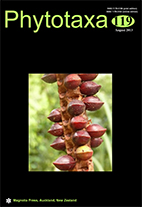Abstract
With more than 500 species, Mimosa L. is one of the largest genera of the Leguminosae. It exhibits considerable trichome diversity among species. Trichome types have been used as diagnostic characters, but some are not well known and have been poorly described in taxonomic works, causing some difficulties for species identification and description. The morphology of trichomes of 35 species was studied using scanning electron microscopy and light microscopy to define the types of trichomes precisely. An ancestral character state reconstruction using a densely-sampled phylogeny of the genus was performed in order to investigate the evolution of trichome types in Mimosa. Two basic types of trichomes can be distinguished: glandular and non-glandular. The glandular trichomes can be sessile or stalked. The non-glandular trichomes can be unbranched or branched. Unbranched trichomes are unicellular and conical or cylindrical, whereas branched trichomes are multicellular and verruciform, medusiform, plumose, barbellate, stellate, stellate-lepidote, or lepidote. Character optimization analysis suggests that glandular and branched trichomes are derived and evolved independently in different lineages within Mimosa. The ancestral condition in Mimosa was probably non-glandular and unbranched trichomes, which was retained from piptadenioid ancestors. Our study provides a first insight into the evolutionary history of trichome morphology in the genus. Despite high levels of homoplasy, trichome morphology offers a set of characters that can be used for differentiating species and species groups in combination with other characters.

